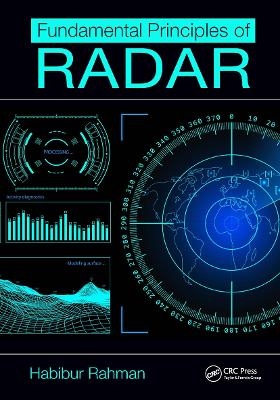
Fundamental Principles of Radar
Seiten
2019
CRC Press (Verlag)
978-1-138-38779-9 (ISBN)
CRC Press (Verlag)
978-1-138-38779-9 (ISBN)
This book provides a comprehensive set of radar principles and covers a broad spectrum of radar types. The book will help readers to be confident in first-order radar design and fundamental technical issues. Most chapters are self-contained and can be very useful for readers seeking selective topics.
The important and fascinating topics of radar enjoy an extensive audience in industry and government but deserve more attention in undergraduate education to better prepare graduating engineers to meet the demands of modern mankind. Radar is not only one of the major applications of electronics and electromagnetic communications, but it is also a mature scientific discipline with significant theoretical and mathematical foundations that warrant an intellectual and educational challenge.
Fundamental Principles of Radar is a textbook providing a first exposure to radar principles. It provides a broad concept underlying the basic principle of operations of most existing radar systems and maintains a good balance of mathematical rigor to convince readers without losing interest. The book provides an extensive exposition of the techniques currently being used for radar system design, analysis, and evaluation. It presents a comprehensive set of radar principles, including all features of modern radar applications, with their underlying derivations using simple mathematics. Coverage is limited to the main concepts of radar in order to present them in a systematic and organized fashion. Topics are treated not as abstruse and esoteric to the point of incomprehensibility, but the very complex and rich technology of radar is distilled into its fundamentals. The author’s emphasis is on clarity without sacrificing rigor and completeness, thus making the book broad enough to satisfy a variety of backgrounds and interests. Thorough documentation provides an unusual degree of completeness for a textbook at this level, with interesting and sometimes thought-provoking content to make the subject even more appealing.
Key Features:
Covers a wide range of topics in radar systems
Includes examples and exercises to reinforce the concepts presented and explain their applications
Provides self-contained chapters useful for readers seeking selective topics
Provides broad concepts underlying the basic principles of operations of most types of radars in use today
Includes documentation to lead to further reading of interesting concepts and applications
The important and fascinating topics of radar enjoy an extensive audience in industry and government but deserve more attention in undergraduate education to better prepare graduating engineers to meet the demands of modern mankind. Radar is not only one of the major applications of electronics and electromagnetic communications, but it is also a mature scientific discipline with significant theoretical and mathematical foundations that warrant an intellectual and educational challenge.
Fundamental Principles of Radar is a textbook providing a first exposure to radar principles. It provides a broad concept underlying the basic principle of operations of most existing radar systems and maintains a good balance of mathematical rigor to convince readers without losing interest. The book provides an extensive exposition of the techniques currently being used for radar system design, analysis, and evaluation. It presents a comprehensive set of radar principles, including all features of modern radar applications, with their underlying derivations using simple mathematics. Coverage is limited to the main concepts of radar in order to present them in a systematic and organized fashion. Topics are treated not as abstruse and esoteric to the point of incomprehensibility, but the very complex and rich technology of radar is distilled into its fundamentals. The author’s emphasis is on clarity without sacrificing rigor and completeness, thus making the book broad enough to satisfy a variety of backgrounds and interests. Thorough documentation provides an unusual degree of completeness for a textbook at this level, with interesting and sometimes thought-provoking content to make the subject even more appealing.
Key Features:
Covers a wide range of topics in radar systems
Includes examples and exercises to reinforce the concepts presented and explain their applications
Provides self-contained chapters useful for readers seeking selective topics
Provides broad concepts underlying the basic principles of operations of most types of radars in use today
Includes documentation to lead to further reading of interesting concepts and applications
Habib Rahman, PhD, is a Professsor of Electrical and Computer Engineering at Saint Louis University. His interests include electromagnetic fields and applications, radar systems design and analysis, satellite communications, and engineering education.
1. Introduction 2. Radar Fundamentals 3. Radar Equations 4. Targets and Interference 5. Propagation of Radar Waves 6. Continuous Wave (CW) Radars 7. MTI and Pulse Doppler Radars 8. Pulse Compression Radar 9. Synthetic Aperture Radars 10. Tracking Radars 11. Aperture and Phased Array Antennas 12. Radar Height Finder and Altimeter 13. Radar Electronic Warfare 14. Over-the-Horizon Radar 15. Secondary Surveillance Radar
| Erscheinungsdatum | 05.06.2019 |
|---|---|
| Zusatzinfo | 7 Tables, black and white; 165 Illustrations, black and white |
| Verlagsort | London |
| Sprache | englisch |
| Maße | 178 x 254 mm |
| Gewicht | 786 g |
| Themenwelt | Technik ► Elektrotechnik / Energietechnik |
| Technik ► Nachrichtentechnik | |
| ISBN-10 | 1-138-38779-7 / 1138387797 |
| ISBN-13 | 978-1-138-38779-9 / 9781138387799 |
| Zustand | Neuware |
| Informationen gemäß Produktsicherheitsverordnung (GPSR) | |
| Haben Sie eine Frage zum Produkt? |
Mehr entdecken
aus dem Bereich
aus dem Bereich
Technologie – Berechnung – Klimaschutz
Buch | Hardcover (2023)
Hanser (Verlag)
39,99 €


